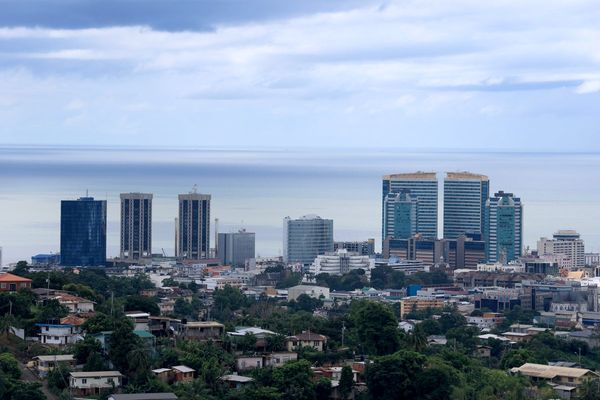
The European Commission will present a plan this autumn to significantly boost high-speed rail travel in Europe, the bloc’s transport commissioner has said, promising a “long-term vision for a more connected, efficient and competitive network across Europe”.
Apostolos Tzitzikostas, the EU’s transport commissioner, said the project would involve the “coordinated planning, financing and implementation” of high-speed rail infrastructure and of rolling stock that could operate across national borders.
The EU is determined to build genuine “passenger-centred, attractive and affordable rail services”, he said, with faster lines and smoother cross-border rail travel considered crucial to the bloc’s competitiveness and climate goals.
“Ultimately, people will choose the train not just because it is more sustainable but because it is the more comfortable, faster and more affordable option for long-distance travel in Europe,” Tzitzikostas said. “That is our direction of travel.”
Long-distance rail travel in Europe has long suffered from poor coordination and connectivity, with different line gauges, rolling stock specifications, operating technologies and signalling systems hampering cross-border links.
A survey published last month suggested that three in four EU citizens would prefer to take a high-speed train instead of a plane if connections between capitals and major urban areas were fast and reliable. But according to a 2021 report by the commission, rail accounted for less than 10% of cross-border EU travel.
With a 90% fall in transport emissions part of the blueprint for the bloc’s pledge of climate neutrality by 2050, getting more people on to trains is vital: Amsterdam to London by train, for example, saves 93% of carbon dioxide over the same journey by plane.
But cash-strapped national operators tend to prioritise domestic services. New infrastructure – and trains capable of operating across borders – are expensive. While new routes have opened and others are on the way, for most Europeans, the plane is faster on most journeys.
The commission has previously set a goal of doubling high-speed rail traffic from 2015 levels by 2030, and trebling it by 2050, via a proposed 49,400km, €546bn (£476bn) high-speed rail network connecting all EU capitals and major cities at speeds of 250km/h (155mph) or more.
Tzitzikostas said his new plan would help achieve that goal, which was attainable if “we address systemic bottlenecks”. The issue was not just more EU money, he said, although rail would be a major beneficiary of a 100% boost to the transport infrastructure budget.
“We need a coordinated financing approach, combining the best use of EU funding, national support and private investment,” he said. But new high-speed lines – and improved existing ones – would not be enough on their own.
“It’s also about ensuring that infrastructure is used effectively,” Tzitzikostas said. “Making sure new operators can access the market, that new standardised rolling stock is available, and that the network is managed as a single system, with similar operating rules and conditions.”
Connectivity is not the only issue. As well as being faster, air travel is often cheaper – and easier to book. A 2023 Greenpeace report which assessed 112 European routes found that trains were, on average, twice as expensive as planes.
T&E, a transport and clean energy advocacy group, says air travel is artificially cheap mainly because all parts of the sector – from airports through plane manufacturers through to airlines – are subsidised by local, regional, national and EU authorities, while airlines are exempt from paying tax on their fuel and VAT on their tickets.
Cross-border train passengers dream of the seamless through tickets available to flyers. European train operators share little ticket information with each other or with booking platforms, forcing passengers to buy multiple separate tickets.
While EU plans for a single booking system met with resistance, Tzitzikostas said the EU was now working to make ticket-buying easier by ensuring all operators and vendors could access ticket sales platform and improving passenger rights.
Without smoother rail connections, lower prices and one-stop ticketing, air travel still has the edge. But if rail can deliver a “comfortable, affordable, easy-to book service”, passengers will respond, Tzitzikostas insisted. “More are choosing high-speed rail already – not just because it’s more sustainable, but because it’s better.”
At present, though, national priorities “do not always align with European ambitions”, due in part to domestic pressure on resources, he said. Interoperability was also a real challenge: “Trains still face too many ‘borders’ within Europe. All this will close collaboration, and funding.”
The substantial investment needed to complete a European high-speed network by 2040, the commission’s target, would necessarily involve “innovative funding and financing mechanisms”, he said: “After all, return on investment here is entirely predictable.”
Referring to the airline sector, Tzitzikostas said the commission’s goal was to “build a fairer and more sustainable level playing field – allowing people to make climate-friendly choices, but also keeping mobility accessible and affordable for all”.
Next year’s launch of a direct 11-hour Prague-Berlin-Copenhagen service, however, showed just how strong the demand for high-speed rail travel now was, he said – and would only increase as assorted lines under construction would almost halve the journey time.
“I am naturally an optimist, and I’m also a train guy,” he said. “I’m already picturing the day when someone can have lunch in Vesterbro in Copenhagen, step on a train, and arrive for dinner in Wenceslas Square, next door to Prague central station.”







